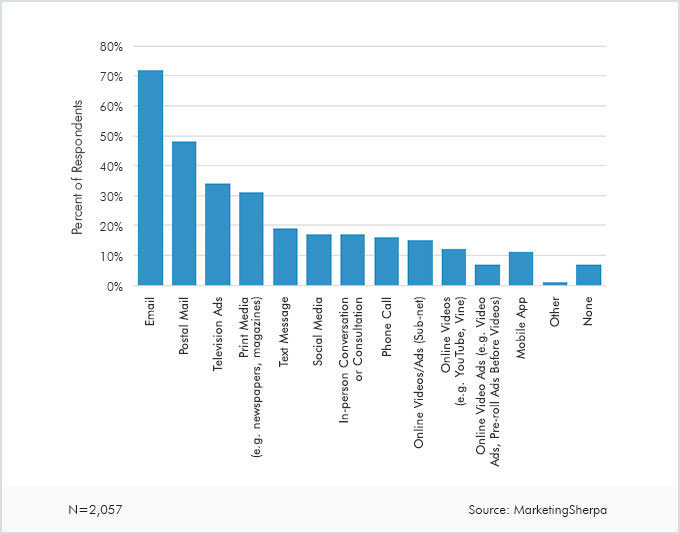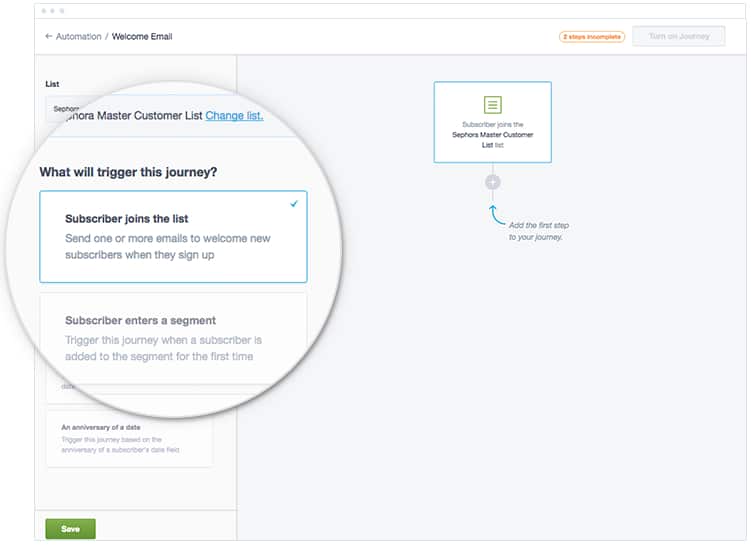This post has been updated as of June 2019
Your clients rely on you to implement the strongest email marketing campaigns that are relevant to their audiences and to their marketing goals. While each client varies, we found through our research that marketers care most about increasing engagement rates, increasing customer acquisition, improving customer retention, and improving email personalization.
We want to take these goals a step further and explore which advanced email marketing strategies can be used in order to achieve them.
Read on to learn how you can collect high-quality contact data for your clients, create segmented and targeted email lists, personalize email campaigns, create engaging content and email design, and use marketing automation tools to streamline the process.
Why email marketing?
Perhaps you’re wondering why email marketing should be the cornerstone of your digital marketing efforts. After all, there are other, newer and trendier marketing channels, right?
It’s true that there are newer channels for reaching your audience (like social media). However, new doesn’t always equate to effective. Let’s discuss five reasons why email marketing should be your major customer relationship-building channel of choice.
1. Customers prefer email
When it comes to communicating with brands, customers prefer using email. Take this discovery made by Marketing Sherpa.

Source: Marketing Sherpa
One of the reasons customers prefer to communicate with brands through email is the fact that it puts them in control of the content they receive. Remember, marketing is all about building relationships with your customers. The best way to do that is to meet them on their communication channel of choice.
2. Email is more personal and direct
Another great reason you need to focus your attention on email marketing is the fact that email is one of the most personal communication channels available. Once a customer has allowed you to send promotional materials into their inbox, it’s a sign that they trust you and are interested in developing a relationship with you.
To be effective, you need to learn advanced email marketing techniques that’ll ensure that your promotions get opened and read. With so many emails being sent and received in a day, it’s easy for a dissatisfied customer to unsubscribe from your list.
When it comes to conversions, email is also the best, as its direct nature makes it easy for you to design a customer journey that’s personalized for each customer.

A well-executed customer journey is key to driving revenue through email marketing and is an advanced email marketing strategy you definitely have to master.
3. Email is easier to track
When it comes to marketing, it’s important to be able to track the performance of your campaigns. With email, it’s easier to track all your important metrics within your ESP’s dashboard, therefore making it easier to calculate your email marketing ROI.
The ability for you to track the performance also makes it easier for you to tweak and adjust the parts of your campaign that aren’t working, thus increasing your efficiency.
4. Email easily integrates with other marketing channels
One thing that’s certain about marketing is that you can’t rely on one method to reach your customers. No matter your current marketing system, email can easily integrate with it. For example, if you rely on inbound traffic through your blog, you can easily integrate email with it to drive traffic to your website.
5. Email is easy to set up, yet highly effective
Probably the biggest reason you need to embrace email marketing as one of your top marketing strategies is the fact that it’s cost-effective, easy to implement, and yet highly effective. You can set up your email marketing platform in a couple of hours and launch your first campaign. It’s that easy.
Implement advanced email marketing strategies.
Now that you know why email marketing is essential, let’s take a look at some advanced email marketing strategies you can easily implement.
1. Collecting high-quality contact data for your clients
The foundation of all successful email marketing strategies is having high-quality contact data in place about your clients’ subscribers. If you don’t know who their subscribers are and what they care about the most, it’s very difficult to engage, acquire, and retain more customers.
A great place to start gathering quality data is by making sure you have the right fields in your clients’ signup forms. When subscribers sign up for your clients’ email newsletters, you can prompt them to enter relevant data, like their industry, company size, revenue, gender, economic status, occupation, location, marital status, age, etc.
This data will help you to better understand who your clients’ audiences are and how you can best relate to them.
Another powerful way to collect data is through using third-party integrations and apps, as well as tapping into the power of an API. You can use data from your clients’ CRM, e-commerce platforms like Shopify, and other apps as the fuel (along with content) for their email marketing campaigns.
The richer your data and the more up-to-date your email lists and segments are, the higher your ROI on email marketing can be. Chances are, your clients have most of the data you need in order to power their campaigns, but you’ll need strong integrations across platforms in order to connect the data to your email marketing strategies.
According to Campaign Monitor’s CMO, Andrea Wildt, marketers will begin to focus on behavioral data across different devices in order to better understand and capture customers’ attention.
She says, “Behavioral data enables marketers to divide their audiences into segments on the basis of preferences, allowing them to use tactics like personalization and relevant content to deliver the right message at precisely the right time.”
Using consumer behavioral data and other data points will help to create segmented and targeted lists for your clients. The more high-quality data you have, the more personalized and engaging you can be in your email campaigns.
2. Create segmented lists of your clients’ subscribers
Once you collect relevant data points, creating different segmented lists will help you to send personalized emails at scale. For example, let’s say your client is a car company who’s having a special promotion in Texas.
You can choose to target subscribers living in Texas between the ages of 25-45 in order to send unique email campaigns that’re most relevant to those subscribers.
The idea behind having segmented lists is making sure that each subscriber receives content that’s extra relevant to them and, thus, engaging and personalized. According to a Janrain study, 74% of online customers are frustrated when they receive content that’s irrelevant to their interests.
These segments help every subscriber feel as though your clients’ brands understand who they are and what they care about the most. The segments also help to build brand loyalty when subscribers grow to trust your clients’ brands through the relationships you build for them.
3. Get personal with your clients’ audiences
Your client’s subscribers want to feel as though your client knows who they are and is listening to what they need from your client’s brand.
Marketing automation allows you to send individualized and personalized messages at scale, while still making sure that each reader feels engaged.
Emails with personalized subject lines are 26% more likely to be opened, and marketers have found a 760% increase in email revenue from segmented campaigns.

Having high-quality contact data and segmented lists will allow you to appeal to each subscriber’s interests. In the words of marketing expert Ardath Albee, “When you get a message that really resonates, it drives intent and action.” One way to do this is by sending automated behavior-triggered emails. These include welcome emails, subscriber anniversary emails, or automated emails based on products a customer was previously interested in.
Another way to make sure that email stays personalized and relevant is by creating an email preference center. Here, you can make sure that your clients’ subscribers tell your client what they’re most interested in and how many emails they’d like to see in their inbox. Following their preferences can lead to higher engagement and customer loyalty.
It’s important to have the bandwidth and the right resources in order to make email personalization easier and more effective. Marketing automation tools, data analytics, and a strong marketing team can transform the way you communicate with your clients’ customers.
4. Use dynamic content with engaging design
While marketing automation and data points are crucial to successful email marketing, they won’t impact your clients’ subscribers unless the content is dynamic and the design is engaging.
Subscribers want to relate to your clients’ brands in a genuine way. Dynamic storytelling content, as well as educational, entertaining, and thought leadership pieces can help to build strong relationships with your clients’ customers.
Editor in Chief at Contently, Joe Lazauskas, put it perfectly when he said, “If you create something original and great, you have the opportunity to monopolize consumer attention and leave your competitors in the shadows.”
While written content is important, so are visuals and design templates in your emails. Using special email design grids, imagery, graphics, and colors can help grab each reader’s attention.
It’s also important to use responsive email design, since 63% of email opens are occurring on mobile devices.
One of the most important features to any campaign is having a “stand-out” CTA. Placement, colors, and the wording of a CTA influence how a subscriber decides to take the next step.
5. Use marketing automation to measure and streamline email campaigns
Marketing automation tools and having strong marketing teams in place are the best resources you can use in order to implement these strategies.
Marketing automation will allow you to collect high-quality contact data, develop segmented lists, send personalized content at scale, and even use engaging email design templates.
Marketing automation will also help you to use data analytics and integrations in order to understand more about your clients’ customers.
You can measure where traffic is coming from, how each subscriber is engaging with your email campaigns, and look at data that goes way beyond click and open rates. These tools will help you to reach the right people at the right time, while sending them targeted messages.
It’s important to find the right tools that work for your agency as well as for your clients. You might have a partnership where your client manages the software, you manage it together, or you white-label the product and manage it on your own.
Whichever way you decide to manage the software, make sure to find one that has the features you need.
Wrap up
Collecting high-quality data through signup forms, third-party apps, and integrations can help you to divide your clients’ subscribers into segmented lists.
These lists will then allow you to send personalized and targeted campaigns filled with engaging content that resonates with your clients’ subscribers.
To measure the effectiveness of your campaigns and carry out these strategies, it’s important to have the right marketing automation tool in place.
These advanced email marketing strategies can help you to meet your clients’ email marketing goals when it comes to customer engagement, retention, and acquisition.
For more tips on making sure that your email marketing campaigns achieve their goals, check out our guide on email marketing best practices to follow.
This post was originally published May 2017





